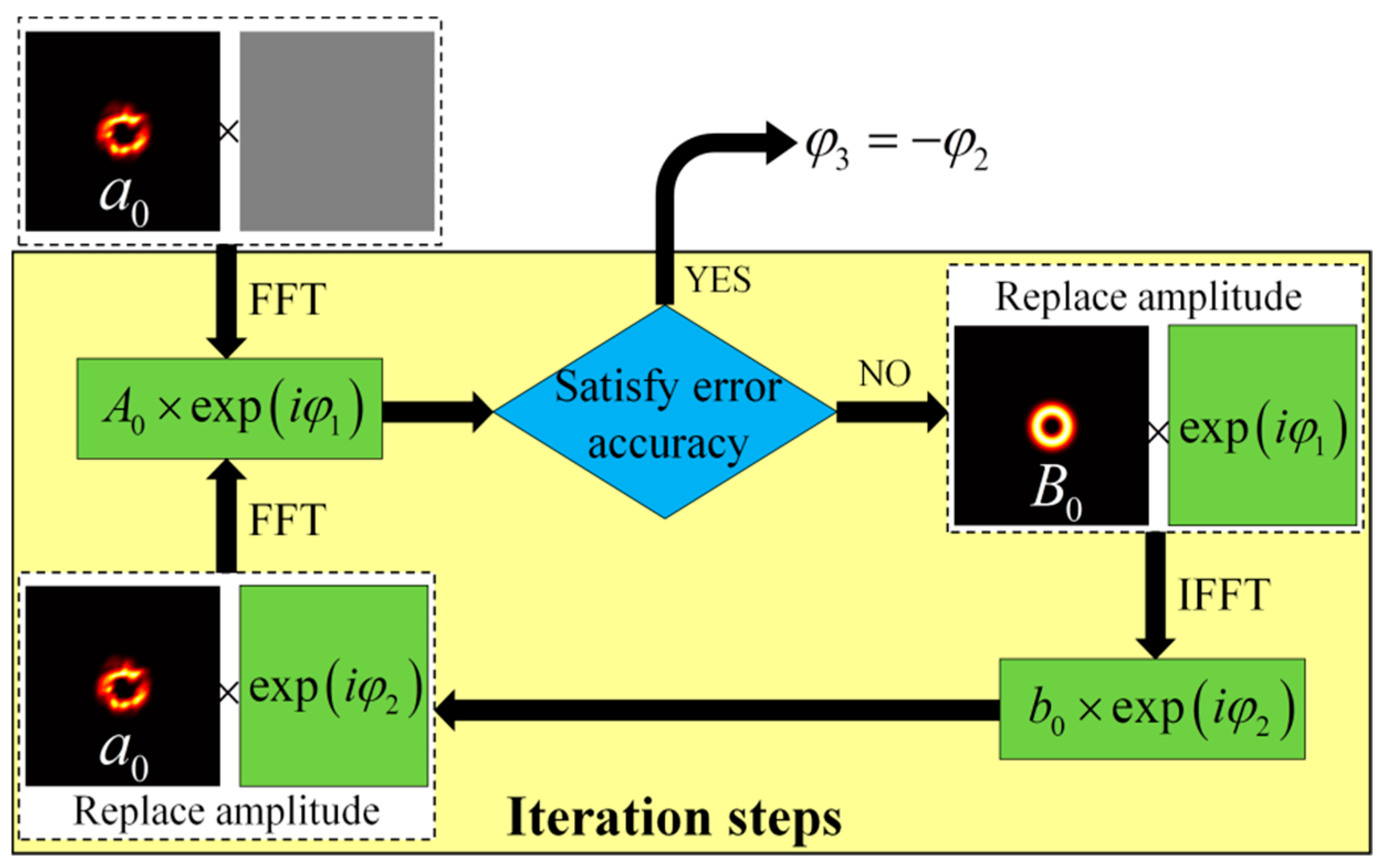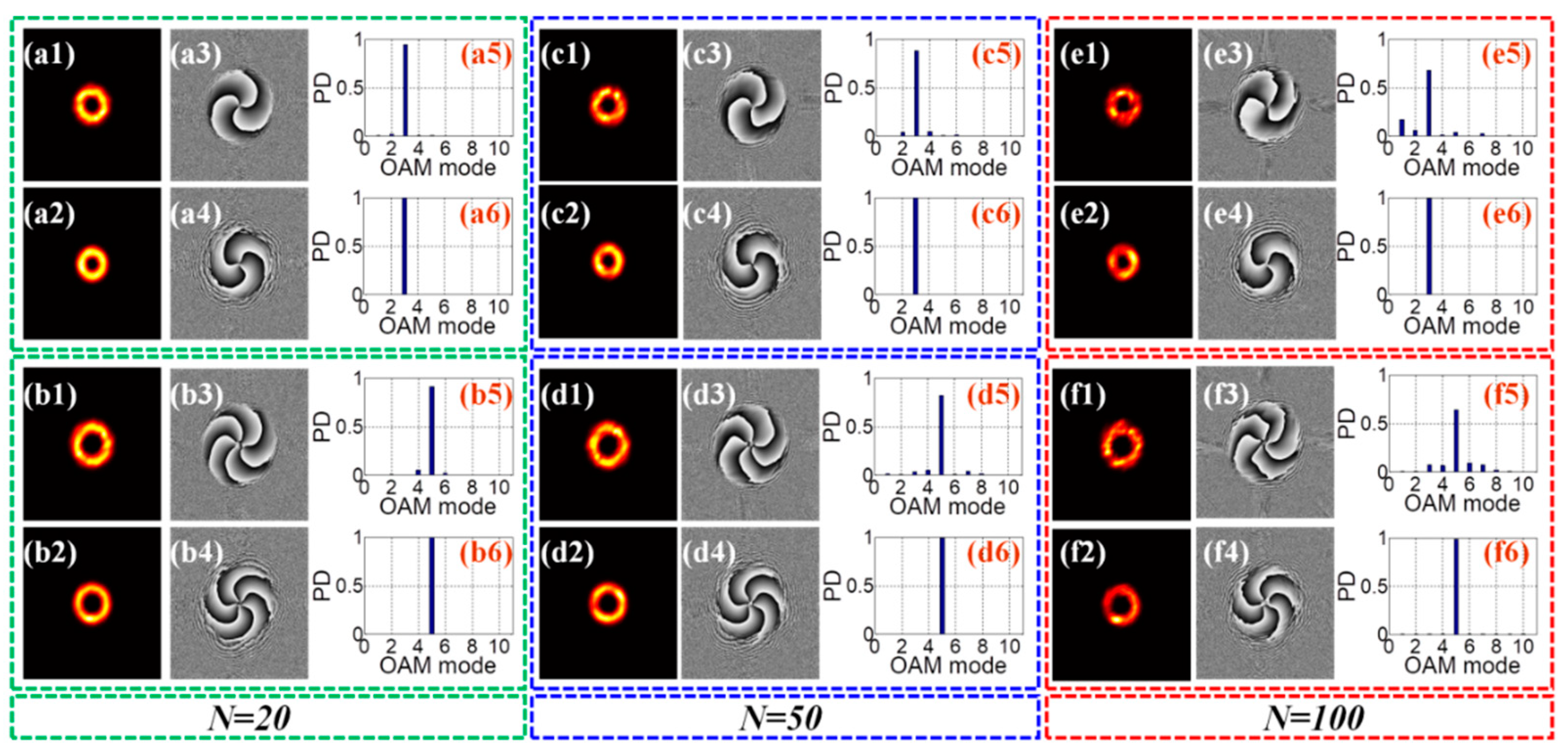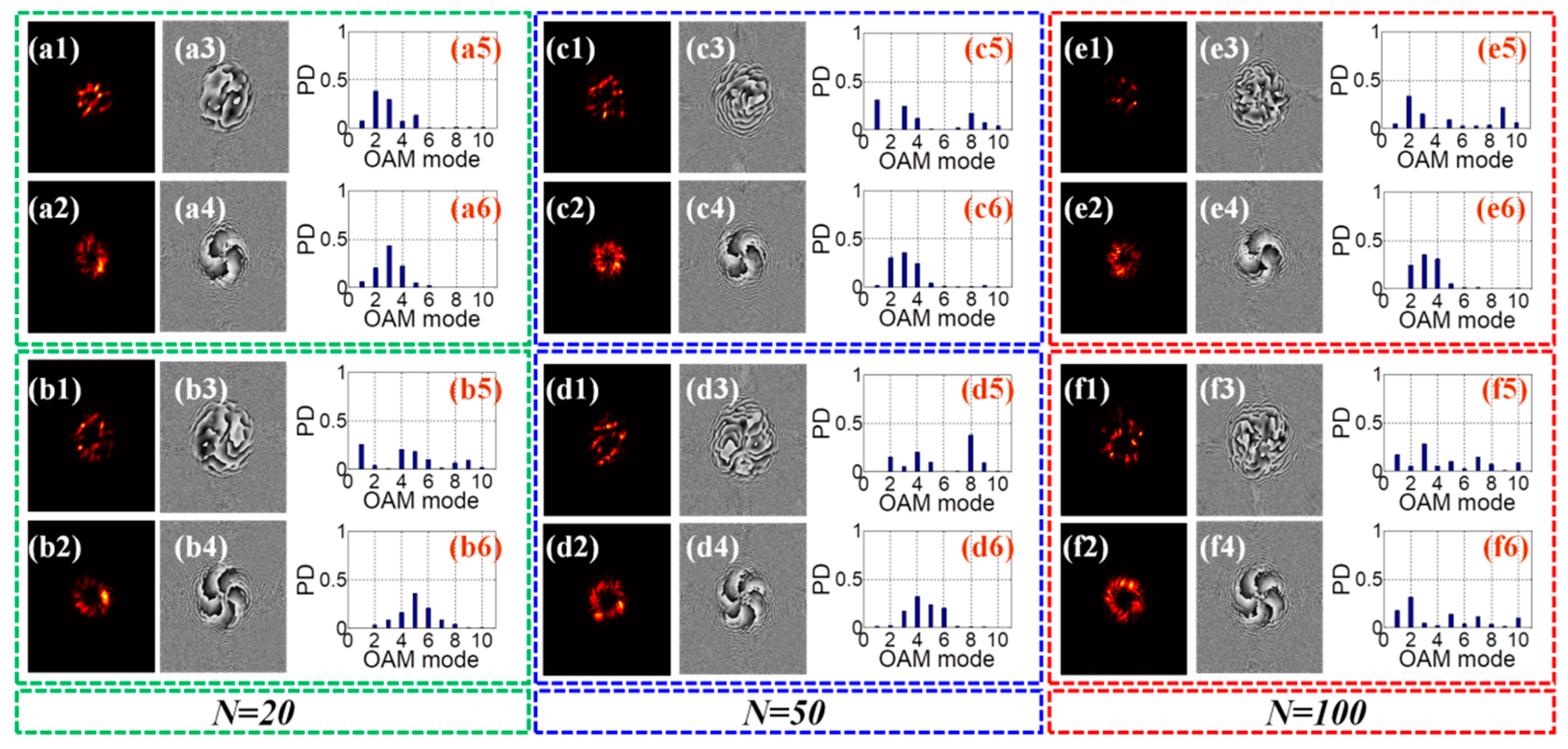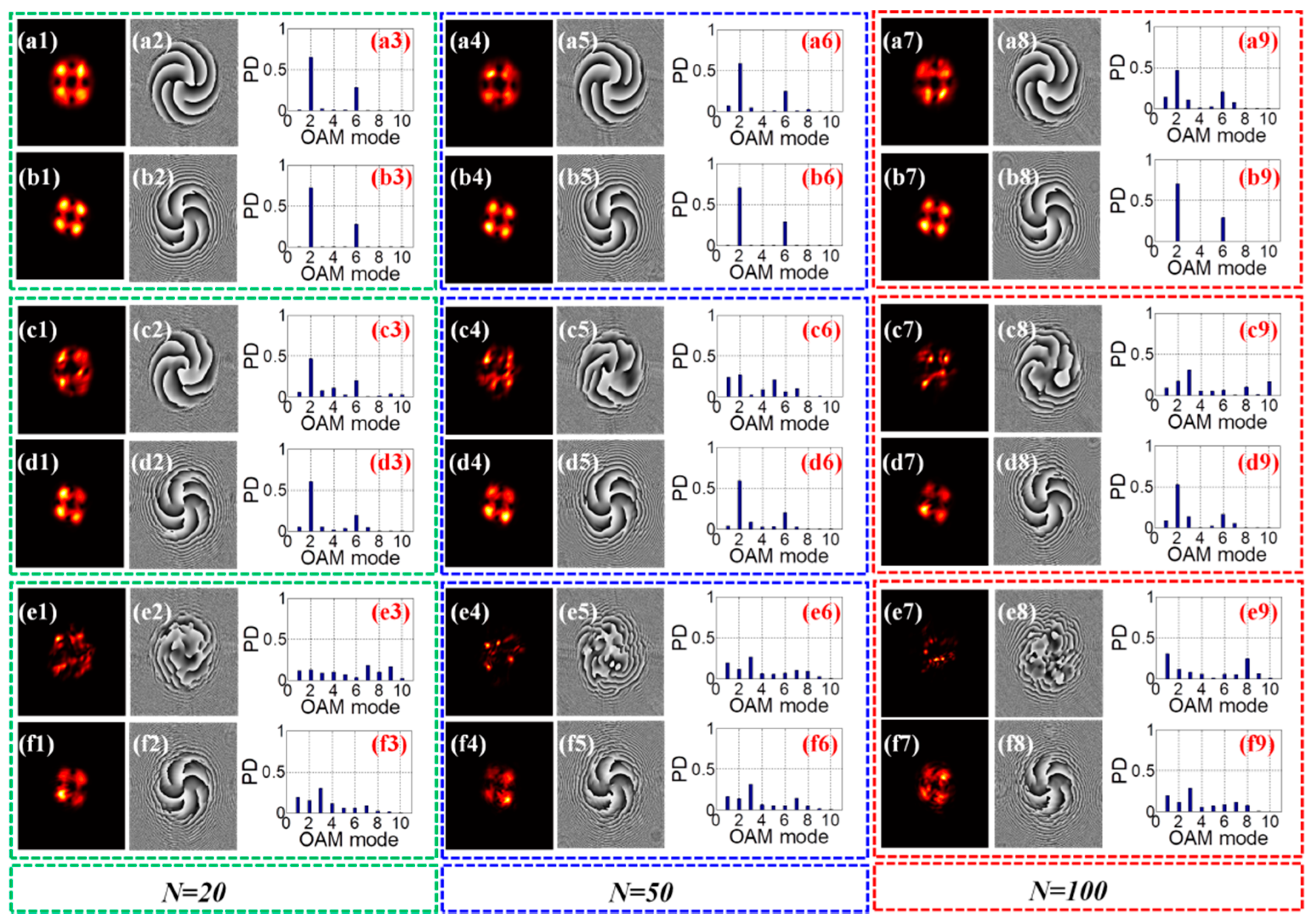Retrieving Performances of Vortex Beams with GS Algorithm after Transmitting in Different Types of Turbulences
Abstract
1. Introduction
2. Materials and Methods
2.1. The Description of the Orbital Angular Momentum
2.2. The Model of Atmospheric Turbulence
2.3. The Theory of GS Algorithm
3. Results
4. Conclusions
Author Contributions
Funding
Conflicts of Interest
References
- Allen, L.; Beijersbergen, M.W.; Spreeuw, R.J.C.; Woerdman, J.P. Orbital angular momentum of light and the transformation of Laguerre-Gaussian laser modes. Phys. Rev. A 1992, 45, 8185. [Google Scholar] [CrossRef]
- Gibson, G.; Courtial, J.; Padgett, M.J.; Vasnetsov, M.; Pas’ko, V.; Barnett, S.M.; Franke-Arnold, S. Free-space information transfer using light beams carrying orbital angular momentum. Opt. Express 2004, 12, 5448–5456. [Google Scholar] [CrossRef] [PubMed]
- Yao, A.M.; Padgett, M.J. Orbital angular momentum: Origins, behavior and applications. Adv. Opt. Photonics 2011, 3, 161–204. [Google Scholar] [CrossRef]
- Allen, L.; Padgett, M.J.; Babiker, M. IV The orbital angular momentum of light. Prog. Opt. 1999, 39, 291–372. [Google Scholar]
- Chan, V.W. Free-space optical communications. J. Lightwave Technol. 2006, 24, 4750–4762. [Google Scholar] [CrossRef]
- Guo, Z.; Wang, Z.; Dedo, M.I.; Guo, K. The Orbital Angular Momentum Encoding System with Radial Indices of Laguerre–Gaussian Beam. IEEE Photonics J. 2018, 10, 1–11. [Google Scholar] [CrossRef]
- Kai, C.; Huang, P.; Shen, F.; Zhou, H.; Guo, Z. Orbital angular momentum shift keying based optical communication system. IEEE Photonics J. 2017, 9, 1–10. [Google Scholar] [CrossRef]
- Kai, C.; Feng, Z.; Dedo, M.I.; Huang, P.; Guo, K.; Shen, F.; Gao, J.; Guo, Z. The performances of different OAM encoding systems. Opt. Commun. 2019, 430, 151–157. [Google Scholar] [CrossRef]
- Wang, J. Advances in communications using optical vortices. Photonics Res. 2016, 4, B14–B28. [Google Scholar] [CrossRef]
- Willner, A.E.; Huang, H.; Yan, Y.; Ren, Y.; Ahmed, N.; Xie, G.; Bao, C.; Li, L.; Cao, Y.; Zhao, Z.; et al. Optical communications using orbital angular momentum beams. Adv. Opt. Photonics 2015, 7, 66–106. [Google Scholar] [CrossRef]
- Wang, J.; Yang, J.-Y.; Fazal, I.M.; Ahmed, N.; Yan, Y.; Huang, H.; Ren, Y.; Yue, Y.; Dolinar, S.; Tur, M.; et al. Terabit free-space data transmission employing orbital angular momentum multiplexing. Nat. Photonics 2012, 6, 488. [Google Scholar] [CrossRef]
- Liu, C.; Guo, Z.; Li, Y.; Wang, X.; Qu, S. Manipulating ellipsoidal micro-particles by femtosecond vortex tweezers. J. Opt. 2015, 17, 035402. [Google Scholar] [CrossRef]
- Zhu, L.; Guo, Z.; Xu, Q.; Zhang, J.; Zhang, A.; Wang, W.; Liu, Y.; Li, Y.; Wang, X.; Qu, S. Calculating the torque of the optical vortex tweezer to the ellipsoidal micro-particles. Opt. Commun. 2015, 354, 34–39. [Google Scholar] [CrossRef]
- Shi, B.; Ding, D.; Zhang, W. Quantum storage of orbital angular momentum entanglement in cold atomic ensembles. J. Phys. B At. Mol. Opt. Phys. 2018, 51, 032004. [Google Scholar] [CrossRef]
- Leach, J.; Jack, B.; Romero, J.; Jha, A.K.; Yao, A.M.; Franke-Arnold, S.; Ireland, D.G.; Boyd, R.W.; Barnett, S.M.; Padgett, M.J. Quantum correlations in optical angle–orbital angular momentum variables. Science 2010, 329, 662–665. [Google Scholar] [CrossRef]
- Nagali, E.; Sansoni, L.; Sciarrino, F.; de Martini, F.; Marruci, L.; Piccrillo, B.; Karimi, E.; Santamato, E. Optimal quantum cloning of orbital angular momentum photon qubits through Hong–Ou–Mandel coalescence. Nat. Photonics 2009, 3, 720. [Google Scholar] [CrossRef]
- Robbert jan Voogd, M.S.; Pereira, A.S.V.; Joseph, J.M.B. The use of orbital angular momentum of light beams for super-high density optical data storage. Opt. Soc. Am. 2004, 5380, 387–392. [Google Scholar]
- Anguita, J.A.; Neifeld, M.A.; Vasic, B.V. Turbulence-induced channel crosstalk in an orbital angular momentum-multiplexed free-space optical link. Appl. Opt. 2008, 47, 2414–2429. [Google Scholar] [CrossRef]
- Chandrasekaran, N.; Shapiro, J.H. Photon information efficient communication through atmospheric turbulence–Part I: Channel model and propagation statistics. J. Lightwave Technol. 2014, 32, 1075–1087. [Google Scholar] [CrossRef]
- Rodenburg, B.; Lavery, M.P.; Malik, M.; O’Sullivan, M.N.; Mirhosseini, M.; Robertson, D.J.; Padgett, M.; Boyd, R.W. Influence of atmospheric turbulence on states of light carrying orbital angular momentum. Opt. Lett. 2012, 37, 3735–3737. [Google Scholar] [CrossRef]
- Paterson, C. Atmospheric turbulence and orbital angular momentum of single photons for optical communication. Phys. Rev. Lett. 2005, 94, 153901. [Google Scholar] [CrossRef]
- Ren, Y.; Huang, H.; Xie, G.; Ahmed, N.; Yan, Y.; Erkmen, B.I.; Chandrasekaran, N.; Lavery, M.P.J.; Steinhoff, N.K.; Tur, M.; et al. Atmospheric turbulence effects on the performance of a free space optical link employing orbital angular momentum multiplexing. Opt. Lett. 2013, 38, 4062–4065. [Google Scholar] [CrossRef]
- Boyd, R.W.; Rodenburg, B.; Mirhosseini, M.; Barnett, S.M. Influence of atmospheric turbulence on the propagation of quantum states of light using plane-wave encoding. Opt. Express 2011, 19, 18310–18317. [Google Scholar] [CrossRef]
- Fu, S.; Gao, C. Influences of atmospheric turbulence effects on the orbital angular momentum spectra of vortex beams. Photonics Res. 2016, 4, B1–B4. [Google Scholar] [CrossRef]
- Ren, Y.; Wang, Z.; Xie, G.; Li, L.; Willner, A.J.; Cao, Y.; Zhao, Z.; Yan, Y.; Ahmed, N.; Ashrafi, N.; et al. Atmospheric turbulence mitigation in an OAM-based MIMO free-space optical link using spatial diversity combined with MIMO equalization. Opt. Lett. 2016, 41, 2406–2409. [Google Scholar] [CrossRef]
- Ren, Y.; Xie, G.; Huang, H.; Ahmed, N.; Yan, Y.; Li, L.; Bao, C.; Lavery, M.P.J.; Tur, M.; Neifeld, M.A.; et al. Adaptive-optics-based simultaneous pre-and post-turbulence compensation of multiple orbital-angular-momentum beams in a bidirectional free-space optical link. Optica 2014, 1, 376–382. [Google Scholar] [CrossRef]
- Ren, Y.; Huang, H.; Xie, G.; Bao, C.; Li, L.; Ahmed, N.; Yan, Y.; Willner, M.; Lavery, M.P.J.; Tur, M.; et al. Simultaneous pre-and post-turbulence compensation of multiple orbital-angular-momentum 100-Gbit/s data channels in a bidirectional link using a single adaptive-optics system. Opt. Soc. Am. 2013, FW6B, 6. [Google Scholar]
- Ren, Y.; Xie, G.; Huang, H.; Bao, C.; Yan, Y.; Ahmed, N.; Lavery, M.P.J.; Erkmen, B.I.; Dolinar, S.; Tur, M.; et al. Adaptive optics compensation of multiple orbital angular momentum beams propagating through emulated atmospheric turbulence. Opt. Lett. 2014, 39, 2845–2848. [Google Scholar] [CrossRef]
- Li, S.; Wang, J. Compensation of a distorted N-fold orbital angular momentum multicasting link using adaptive optics. Opt. Lett. 2016, 41, 1482–1485. [Google Scholar] [CrossRef]
- Fu, S.; Zhang, S.; Wang, T.; Gao, C. Pre-turbulence compensation of orbital angular momentum beams based on a probe and the Gerchberg–Saxton algorithm. Opt. Lett. 2016, 41, 3185–3188. [Google Scholar] [CrossRef]
- Li, M.; Li, Y.; Han, J. Gerchberg–Saxton algorithm based phase correction in optical wireless communication. Phys. Commun. 2017, 25, 323–327. [Google Scholar] [CrossRef]
- Kim, H.-C.; Lee, Y.H. Hermite–Gaussian and Laguerre–Gaussian beams beyond the paraxial approximation. Opt. Commun. 1999, 169, 9–16. [Google Scholar] [CrossRef]
- Doster, T.; Watnik, A.T. Laguerre–Gauss and Bessel–Gauss beams propagation through turbulence: Analysis of channel efficiency. Appl. Opt. 2016, 55, 10239–10246. [Google Scholar] [CrossRef]
- Lane, R.G.; Glindemann, A.; Dainty, J.C. Simulation of a Kolmogorov phase screen. Waves Random Media 1992, 2, 209–224. [Google Scholar] [CrossRef]
- Yang, C.; Xu, C.; Ni, W.; Gan, Y.; Hou, J.; Chen, S. Turbulence heterodyne coherent mitigation of orbital angular momentum multiplexing in a free space optical link by auxiliary light. Opt. Express 2017, 25, 25612–25624. [Google Scholar] [CrossRef]
- Gerchberg, R.W. A practical algorithm for the determination of phase from image and diffraction plane pictures. Optik 1972, 35, 237–246. [Google Scholar]
- Liu, J.S.; Taghizadeh, M.R. Iterative algorithm for the design of diffractive phase elements for laser beam shaping. Opt. Lett. 2002, 27, 1463–1465. [Google Scholar] [CrossRef]
- Bay, C.; Hübner, N.; Freeman, J.; Wilkinson, T. Maskless photolithography via holographic optical projection. Opt. Lett. 2010, 35, 2230–2232. [Google Scholar] [CrossRef]
- Ren, Y.; Huang, H.; Yang, J.-Y.; Yan, Y.; Ahmed, N.; Yue, Y.; Willner, A.E.; Birnbaum, K.; Choi, J.; Erkmen, B.; et al. Correction of phase distortion of an OAM mode using GS algorithm based phase retrieval. In Science and Innovations; Optical Society of America: Washington, DC, USA, 2012; p. CF3I.4. [Google Scholar]
- Fu, S.; Wang, T.; Zhang, S.; Zhang, Z.; Zhai, Y.; Gao, C. Non-probe compensation of optical vortices carrying orbital angular momentum. Photonics Res. 2017, 5, 251–255. [Google Scholar] [CrossRef]







| OAM Mode | W/o or W/ GS | N = 20 | N = 50 | N = 100 |
|---|---|---|---|---|
| l = 3 | W/o GS | 94.96% | 88.09% | 67.94% |
| W/ GS | 99.98% | 99.88% | 96.46% | |
| l = 5 | W/o GS | 91.56% | 82.15% | 64.33% |
| W/ GS | 99.73% | 99.42% | 98.35% |
| OAM Mode | W/o or W/ GS | N = 20 | N = 50 | N = 100 |
|---|---|---|---|---|
| l = 3 | W/o GS | 70.26% | 62.46% | 37.69% |
| W/ GS | 86.24% | 78.16% | 69.58% | |
| l = 5 | W/o GS | 66.49% | 47.57% | 27.27% |
| W/ GS | 82.35% | 73.15% | 60.82% |
| OAM Mode | W/o or W/ GS | N = 20 | N = 50 | N = 100 |
|---|---|---|---|---|
| l = 3 | W/o GS | 27.73% | 24.47% | 15.16% |
| W/ GS | 43.43% | 35.89% | 35.08% | |
| l = 5 | W/o GS | 18.76% | 10.60% | 10.22% |
| W/ GS | 36.17% | 23.31% | 13.84% |
| OAM Mode | W/o or W/ GS | N = 20 | N = 50 | N = 100 | |
|---|---|---|---|---|---|
| l = 2 | W/o GS | 65.10% | 58.70% | 46.88% | |
| l = 6 | 28.43% | 25.03% | 20.80% | ||
| l = 2 | W/ GS | 72.29% | 70.65% | 70.60% | |
| l = 6 | 27.67% | 29.03% | 29.01% | ||
| l = 2 | W/o GS | 46.58% | 26.60% | 17.02% | |
| l = 6 | 19.82% | 6.08% | 6.13% | ||
| l = 2 | W/ GS | 60.69% | 59.07% | 52.63% | |
| l = 6 | 19.63% | 20.03% | 16.58% | ||
| l = 2 | W/o GS | 12.57% | 11.84% | 11.97% | |
| l = 6 | 3.04% | 7.10% | 5.57% | ||
| l = 2 | W/ GS | 15.56% | 13.95% | 11.32% | |
| l = 6 | 5.93% | 5.27% | 8.49% |
© 2019 by the authors. Licensee MDPI, Basel, Switzerland. This article is an open access article distributed under the terms and conditions of the Creative Commons Attribution (CC BY) license (http://creativecommons.org/licenses/by/4.0/).
Share and Cite
Dedo, M.I.; Wang, Z.; Guo, K.; Sun, Y.; Shen, F.; Zhou, H.; Gao, J.; Sun, R.; Ding, Z.; Guo, Z. Retrieving Performances of Vortex Beams with GS Algorithm after Transmitting in Different Types of Turbulences. Appl. Sci. 2019, 9, 2269. https://doi.org/10.3390/app9112269
Dedo MI, Wang Z, Guo K, Sun Y, Shen F, Zhou H, Gao J, Sun R, Ding Z, Guo Z. Retrieving Performances of Vortex Beams with GS Algorithm after Transmitting in Different Types of Turbulences. Applied Sciences. 2019; 9(11):2269. https://doi.org/10.3390/app9112269
Chicago/Turabian StyleDedo, Maxime Irene, Zikun Wang, Kai Guo, Yongxuan Sun, Fei Shen, Hongping Zhou, Jun Gao, Rui Sun, Zhizhong Ding, and Zhongyi Guo. 2019. "Retrieving Performances of Vortex Beams with GS Algorithm after Transmitting in Different Types of Turbulences" Applied Sciences 9, no. 11: 2269. https://doi.org/10.3390/app9112269
APA StyleDedo, M. I., Wang, Z., Guo, K., Sun, Y., Shen, F., Zhou, H., Gao, J., Sun, R., Ding, Z., & Guo, Z. (2019). Retrieving Performances of Vortex Beams with GS Algorithm after Transmitting in Different Types of Turbulences. Applied Sciences, 9(11), 2269. https://doi.org/10.3390/app9112269






